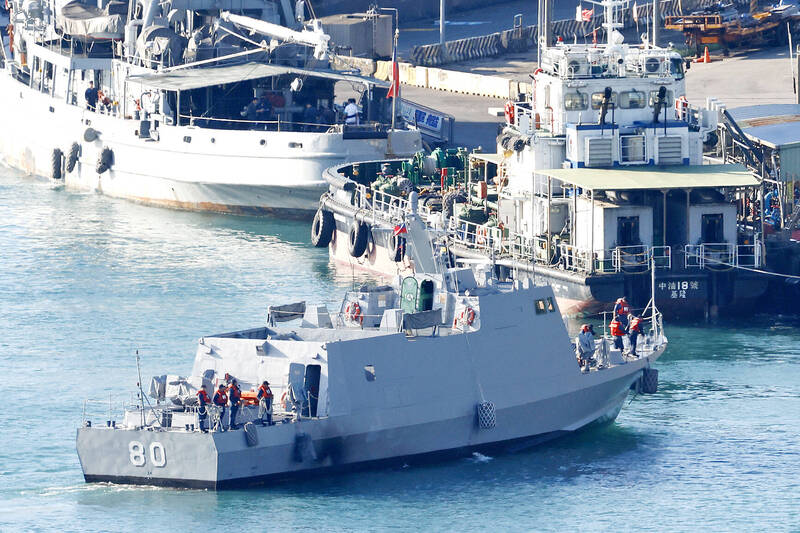《TAIPEI TIMES》 War in Strait risks global trade: report

A Taiwan navy Kuang Hua VI-class missile boat maneuvers at the military harbor in the Port of Keelung yesterday. Photo: Ritchie B. Tongo, EPA-EFE
POTENTIAL BACKLASH: While Beijing has positioned itself as a voice for developing countries, disruptions in the Strait could harm African and BRICS nations, the report said
By Lee I-chia / Staff reporter
Disruptions to trade in the Taiwan Strait, where in 2022 approximately US$2.45 trillion of goods — over one-fifth of global maritime trade — transited, would send shock waves well beyond Taiwan and China, a US-based think tank said in a report published just days before Chinese military drills around Taiwan.
The Center for Strategic and International Studies (CSIS) on Thursday published on its Web site a report titled “Crossroads of Commerce: How the Taiwan Strait Propels the Global Economy.”
China’s rising assertiveness has sparked fears that it might soon attempt to use force to bring Taiwan under its control, but Beijing has a range of options short of an invasion at its disposal, the report said.
CSIS research suggested that less kinetic actions, such as a coast guard-led quarantine of Taiwan, are more likely in the short term, and such lower-intensity contingencies could still threaten the trillions of dollars of trade that moves through the Taiwan Strait each year, it said.
Yesterday, the Chinese People’s Liberation Army announced the start of its “Joint Sword-2024B” drills around Taiwan.
More than 90 percent of cutting-edge chips are produced in Taiwan, while Taiwan’s ports in 2022 handled trade worth an estimated US$586 billion, the report said.
Any disruption of commercial traffic through the Strait might prompt shipping companies to stay out of the area to limit risks and avoid paying spiked insurance premiums, it said.
However, forced deviations from well-worn routes come at a cost, including longer journeys and delays that ultimately affect consumers, it said.
Two key US allies, Japan and South Korea, would be among those most affected by disruptions, it said.
Thirty-two percent of Japan’s imports and 25 percent of its exports — totaling nearly US$444 billion — transited the Strait in 2022, and South Korea depended on the waterway for 30 percent of its imports and 23 percent of its exports, amounting to about US$357 billion in goods, the report said.
Both countries rely on the Strait for importing raw materials to meet their immense energy needs, with more than 95 percent of Japan’s and 65 percent of South Korea’s crude oil sourced from a select group of Middle Eastern countries, of which much of the trade passes through the Strait, it said.
As for the effects on other Indo-Pacific countries, nearly 27 percent of Australia’s exports passed through the Taiwan Strait in 2022, totaling almost US$109 billion, it said, adding that the Philippines, Vietnam, Thailand, Laos and Myanmar are less dependent on the waterway.
Moreover, “the Taiwan Strait’s importance is not limited to Indo-Pacific countries,” the report said, adding that the four countries most reliant on the Strait are in Africa.
The Democratic Republic of the Congo shipped nearly US$13 billion of metals — 62 percent of its total global exports — through the Strait, Eritrea used it to export more than 70 percent of its zinc and copper ores to China, and Gabon and Angola shipped about 40 percent of their oil to China through the passage, it said.
Countries in the Middle East are similarly reliant on the Taiwan Strait for transporting oil to Asian markets, with Oman, Saudi Arabia, Iraq, Kuwait, Qatar and Yemen sending more than 30 percent of their exports through it, the report said.
“On average, the nine BRICS economies rely on the Taiwan Strait for about 14 percent of their imports and 15 percent of their exports. That is more than twice the level of dependence of the G7 economies,” it said.
Positioning itself as a leader and voice of developing countries, Beijing’s need to maintain diplomatic support from these nations to advance its vision — an international order beyond the “Western approach” — might make it more sensitive to their concerns, it said.
“Faced with severe disruptions to their trade, they [the developing countries] could collectively exert significant pressure on Beijing to resolve a conflict to avoid long-term economic pain,” it said.
“Ensuring free and open maritime trade through the Taiwan Strait is critical not just for nearby nations like China, South Korea and Japan, but for the entire global economy,” the report said. “For Washington, working closely with allies and partners to maintain cross-strait stability is essential to safeguarding international trade.”
新聞來源:TAIPEI TIMES



















